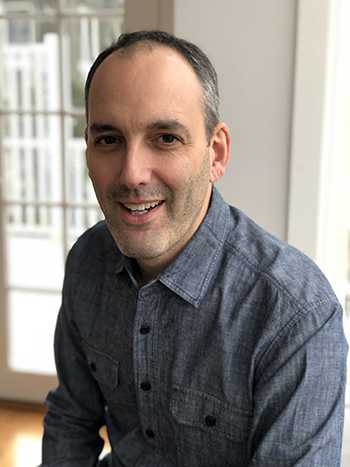Under Your Skin: Molecules and Cells for Touch and Pain
What Alexander Chesler Is Discovering about the Somatosensory System

Alexander Chesler was intrigued to learn that two mutations in a single gene cause dramatic problems in the sensory system.
She was a floppy baby, didn’t stand until she was three years old, could walk at five—but only with assistance—and never ran or jumped. She developed difficulty grasping objects, poor balance and coordination, severe scoliosis, and joint contractures that caused her hands and feet to be abnormally shaped. She can’t distinguish certain types of stimuli on her skin. And when she walks with her eyes closed, she loses her balance. But her brain is fine.
“She has absolutely no cognitive difficulties,” however, said Stadtman Investigator Alexander Chesler (National Center for Complementary and Integrative Health) during a March 12, 2018, talk about his research. “In fact, there are no structural abnormalities in her brain, and she’s incredibly bright. She’s now in college studying engineering.”
It turns out that the young woman (referred to as PS1) has two mutations in the PIEZO2 gene. The discovery was made by National Institute of Neurological Disorders and Stroke senior investigator Carston Bönnemann, who studies the genetic basis for neuromuscular disorders in children. He introduced PS1 to Chesler because of her unusual phenotype. Chesler was intrigued that two mutations in a single gene could “result in this dramatic phenotype.”
Chesler, who’s been at NIH since 2013, is studying those PIEZO2 mutations as well as other genetic and cellular mechanisms that underlie the somatosensory system (the system of neurons involved in the perception of touch, pressure, pain, temperature, position, movement, and vibration). His research focuses on mechanosensation, one part of the somatosensory system.
“Mechanosensation is required for our ability to sense things with our hands—like touch—and to warn us of potential dangers,” explained Chesler. “It also enables us to know where our bodies are in space, called the sense of proprioception.”
In 2010, investigators at Scripps Research Institute (San Diego, California) discovered that the proteins encoded by the PIEZO2 gene are expressed in tissues where mechanical forces influence biological processes such as touch and pain. Chesler is trying to develop a deeper understanding of how mutations in this gene affect the mechanosensation system.

IMAGE BY ALEXANDER CHESLER, NCCIH
Proteins encoded by the PIEZO2 gene are expressed in tissues where mechanical forces influence biological processes such as touch and pain. Mutations in the gene not only wreak havoc with the somatosensory system, but when the PIEZO2 protein is selectively removed from proprioceptors, mice suffer from profound movement difficulties and skeletal abnormalities (right).
Working with mouse models as well as with human patients at the NIH Clinical Center, Chesler’s lab examines the structure, neurochemistry, and function of the neurons underlying the somatosensory system.
In experiments with mice, his lab records the activity in neurons that are stimulated when a mouse’s cheek is stroked or brushed or its hairs are pulled. Recording hundreds of neurons at a time, the lab can decode how different mechanical stimuli affect ensembles of neurons. Furthermore, Chesler’s team has observed that upon removing the Piezo2 protein selectively from proprioceptors, mice suffer from profound movement difficulties and skeletal abnormalities.
After spending years studying the somatosensory system in mice, Chesler—through serendipitous mention of his interests at a faculty meeting—was able to meet PS1. At that point, he extended his work to study the PIEZO2 mutations in humans. He determined that PIEZO2 was required for identifying vibrations, distinguishing among types of touches, and creating sensations at joints. He and his collaborators found that PIEZO2-deficient subjects could not walk across rooms if they were blindfolded. The etiology for the exact differences between PIEZO2 function in mice and in humans is yet to be fully understood, however.
Chesler acknowledged that there is still much to be learned about mechanosensation and proprioception. A better understanding of these processes could help scientists identify new approaches for helping people like PS1 with movement difficulties as well as develop treatments for managing and treating pain.
To watch a video of Chesler’s March 12, 2018, talk, go to https://videocast.nih.gov/launch.asp?23750.
This page was last updated on Thursday, April 7, 2022
